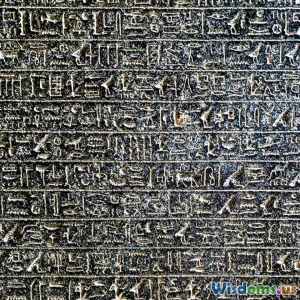
The Linguistic Legacy of Ancient Civilizations
8 min read Explore how ancient civilizations shaped language and communication, revealing enduring linguistic legacies. (0 Reviews)
The Linguistic Legacy of Ancient Civilizations
Language is one of humanity’s most remarkable inventions—an intricate system enabling communication, culture transmission, and the very shaping of civilizations. When we journey back thousands of years, the written and spoken languages of ancient peoples reveal more than just communication—they open intriguing windows into identity, power, and innovation. But what exactly have these ancient tongues bequeathed to us? How did civilizations such as the Sumerians, Egyptians, Mayans, and others craft the linguistic foundation that still resonates in contemporary languages and cultures?
In this exploration, we unpack the fascinating linguistic legacy of ancient civilizations by examining the emergence, evolution, and lasting influence of their languages and scripts.
The Dawn of Writing: Sumerian Contributions
Often crowned as the birthplace of writing, Sumer around 3200 BCE introduced cuneiform, one of the earliest writing systems. Originally developed to keep track of economic transactions, cuneiform evolved to represent sounds and ideas, enabling literature, laws, and administration to flourish.
- Innovation in communication: The transition from pictographs to wedge-shaped symbols pressed into clay tablets allowed for permanence and complexity.
- Epic of Gilgamesh: This ancient poem, documented on cuneiform tablets, is not only one of the earliest known literary works but also a source of mythological and philosophical depth influencing later narratives.
According to renowned Assyriologist Samuel Noah Kramer, the Sumerians “gave the world the oldest known written language,” setting the standard for other early scripts in the ancient Near East.
Hieroglyphs and the Egyptian Linguistic Identity
In Egypt, about the same period, hieroglyphic writing blossomed into a rich visual language comprised of ideograms, phonograms, and determinatives. Unlike cuneiform, Egyptian hieroglyphs were primarily aesthetic and ceremonial.
- The Rosetta Stone discovery, featuring parallel texts in Greek and Egyptian scripts, finally cracked hieroglyphics' code in 1822, transforming our understanding of Ancient Egypt.
- Hieroglyphs captured religious rites and administrative records, illustrating the civilization’s values and worldview.
Egyptologist Dr. Mark Collier highlights that hieroglyphs served not just as communication but as “holy images that linked the language to divine power,” embodying deep cultural symbolism.
The Mayan Glyphs: Complexities of Mesoamerican Writing
Thousands of miles away, the Maya civilization developed an intricate glyphic script around 300 BCE. Known for its blend of logograms and syllabic signs, the Mayan writing system inscribed historical events, astronomical knowledge, and dynastic stories on monuments and codices.
- Years of painstaking decipherment have revealed much, but Maya script remains partly mysterious, captivating archaeologists and linguists alike.
- The calendar system embedded within their written records showcases their sophisticated understanding of time and cosmology.
Linda Schele, a leading Mayanist, once asserted, “The Maya writing was a language tool that not only recorded history but conveyed identity and power for an advanced ancient civilization.”
Language Families: Tracing Roots to Ancient Civilizations
Beyond scripts, many modern languages trace their ancestry to roots established by ancient peoples.
- The Indo-European language family, encompassing languages from English to Hindi, extends to early Proto-Indo-European speakers from the Pontic-Caspian steppe around 4000 BCE.
- Semitic languages, including Hebrew, Arabic, and Aramaic, link back to regions of ancient Mesopotamia and the Levant, famously encoding early religious texts.
- Ancient Chinese, particularly the oracle bone script of the Shang Dynasty, represents the earliest form of a written tradition still alive in modified forms today.
These linguistic lineages affirm that the echoes of ancient languages are embedded within contemporary speech, grammar, and vocabulary.
Unsolved Linguistic Mysteries
While many ancient scripts have been deciphered, some remain cryptic, such as:
- Linear A: Used by the Minoans, this Bronze Age script has eluded researchers for decades despite numerous attempts to unlock its secrets.
- Indus Script: Found on seals from the Indus Valley Civilization, no definitive interpretation exists, with ongoing debates about its nature as writing or symbolic notation.
These linguistic enigmas highlight the limits of current knowledge and the tantalizing potential for future breakthroughs that could reshape our grasp of prehistory.
Why the Linguistic Legacy Matters Today
Understanding ancient languages offers more than scholarly delight; it enriches modern culture, philosophy, and communication:
- Cultural Preservation: Ancient languages and texts provide continuity, connecting modern societies with foundational narratives and traditions.
- Historical Insights: Linguistic data clarifies population migrations, trade, and cross-cultural influences.
- Technological Inspiration: The development of writing systems informs digital typography, programming languages, and artificial intelligence in script recognition.
Moreover, the human drive to decode and revive lost languages fosters international collaboration among archaeologists, linguists, and historians.
Conclusion: A Living Thread Through Time
The linguistic legacy of ancient civilizations is a testament to human ingenuity and the enduring quest to capture thought, culture, and identity through symbols and sounds. From the clay tablets of Sumer to the monumental inscriptions of Egypt and intricate Mayan codices, these early languages influenced not only their own time but resonate through millennia.
By studying these linguistic treasures, we gain more than historic knowledge—we reconnect with humanity’s shared heritage and appreciate the profound ways language shapes who we are. As archaeological and linguistic research continues, new discoveries promise to deepen our understanding of ancient voices speaking across time, reminding us that language is a living thread tying the past to our present and future.
References
- Kramer, Samuel Noah. History Begins at Sumer.
- Collier, Mark. Lectures on Ancient Egyptian Language and Culture.
- Schele, Linda, and Freidel, David. A Forest of Kings: The Untold Story of the Ancient Maya.
- Robinson, Andrew. Lost Languages: The Enigma of the World's Undeciphered Scripts.
- UNESCO and linguistic preservation initiatives.
Embark on exploring these ancient linguistic legacies, and perhaps contribute to the ongoing story of understanding humanity’s earliest voices.
Rate the Post
User Reviews
Popular Posts





















